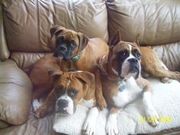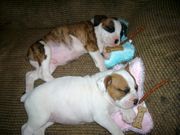History of the Boxer
Home
The Breed
History of the Boxer
Care of Your Boxer
Obedience Training
Holding Deposit Agreement
Pine-Glade Boxers Sale Agreement
Shipping
Birth Announcement
Available Puppies
The Boxer's historical background began in Germany, where he was a working dog developed from several other breeds including the Bulldog and Great Dane. The boxer, with his mastiff-type head and undershot bite, was used to run down and hold large, fierce game such as wild boar, bear, and bison, until the hunter's arrival. The Boxer was bred to be a powerful, muscular dog. In the 1880s, descendants of this type of dog were bred to a taller more elegant English import, and the era of the modern Boxer had begun. Imported to America after the First World War, his popularity really began in the late 1930s. Boxers were then used in WW II as field dogs. They were actually sent out into unknown territories to check for land mines. Unfortunately many innocent and beautiful animals met their death in that manner. Also, at that time, any white boxer puppy was immediately put to death because they were considered too visible in the war zone. This was another reason that for many years white was not considered a register able color. Fortunately, in the early 1990’s both CKC and AKC came to realize that these beautiful creatures still had all the greatest aspects of the boxer breed and changed the registration rules.
Breed Characteristics
The Boxer's official classification in the "Working Group" of dogs is a natural. He is easy to train and has been used for guard, police, and guide dog service. Although always vigilant, the Boxer is not a nervous breed, and will not bark without cause. He has judgment and an uncanny sense of distinguishing between friend and intruder. The Boxer is alert to protect his family but tolerant of any stranger once he knows there is no danger. He is a happy, exuberant dog who delights in children and is eager to play long after he has left puppy hood behind. One of the delightful qualities that set the Boxer apart is the unique mobility of his expressive face, the skin furrowing of the forehead, the dark, "soulful" eyes, and at times almost human attempts to "converse." He mimics the mood of his master and can spend hours quietly lying at his feet. His overall sweet nature has endeared him to generations of Boxer owners and makes his replacement by another breed difficult for one who has owned a Boxer. He is a natural show-off, and many Boxers excel at Conformation, Agility, and Obedience events held in conjunction with both CKC & AKC shows.
Physical Appearance
The Boxer is a medium sized dog ranging from 21" in height for a smaller female to 25" and sometimes more for a taller male. Adult weight may reach 65-80 pounds in the male with the females about 15 pounds less. There are no giant or miniature varieties. The short, close-lying coat comes in two equally acceptable colors - fawn and brindle. The fawn may vary from a tawny tan to a stag red. The brindle ranges from sparse, but clearly defined black stripes on a fawn background to such a heavy concentration of black striping that the essential fawn background color barely, although clearly, shows through - which will create the appearance of reverse brindle. White markings should be of such distribution to enhance the dog’s appearance, but it is not uncommon to have an entirely white Boxer born in a litter or one with predominately white background known as a "check".

